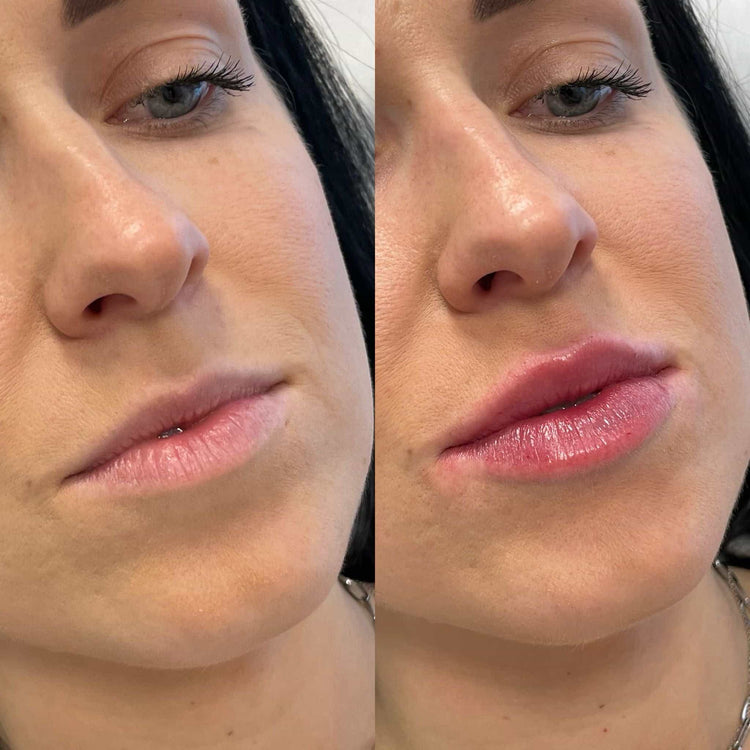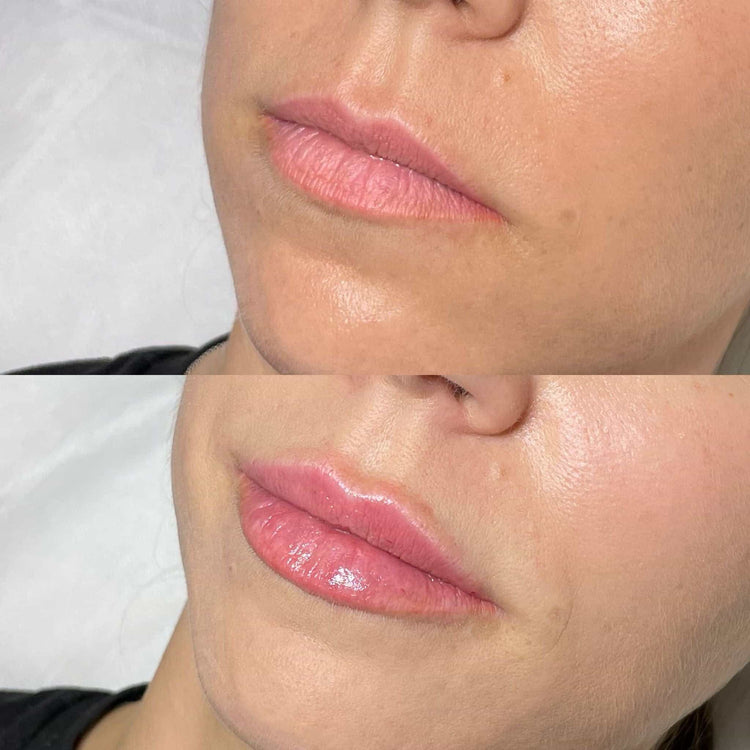Consultation
Considering lip fillers but worried about discomfort? Understanding the process involved can help ease any anxieties you might have.
Assessment and Discussion
The journey to pain-free lip fillers typically begins with a consultation and assessment.
During this initial meeting, a qualified practitioner will listen to your desired outcome, discuss your medical history, and examine your lips. They’ll carefully assess your facial anatomy and advise on the most suitable filler type and placement for your unique features.
Based on the assessment, a treatment plan is developed, addressing your specific needs and goals.
Open communication throughout this process is crucial, allowing you to voice any concerns and ensure you’re comfortable with every step.
Treatment Goals and Expectations
Treatment goals are established collaboratively between you and the practitioner.
This involves discussing your aesthetic aspirations for your lips – whether it’s enhancing volume, defining the Cupid’s bow, correcting asymmetry, or achieving a particular shape.
Realistic expectations are also crucial during this stage. Your practitioner will guide you on achievable results based on your facial structure and individual anatomy.
Pre-Procedure Preparation

Understanding the process involved in obtaining pain-free lip fillers can ease any anxieties you might have. Before the procedure, a consultation and assessment with a qualified practitioner are crucial.
Numbing Cream Application
Pre-procedure preparation is essential for a comfortable experience. One effective method is the application of a topical numbing cream to minimize discomfort during the filler injection. This cream is typically applied to the lips about 30 minutes prior to the treatment, allowing it time to take effect.
The numbing cream helps to reduce sensitivity in the area, making the procedure more tolerable.
It’s important to follow the practitioner’s instructions regarding application and duration of use for optimal results.
Medical History Review
During this initial meeting, a qualified practitioner will listen to your desired outcome, discuss your medical history, and examine your lips. They’ll carefully assess your facial anatomy and advise on the most suitable filler type and placement for your unique features.
A thorough review of your medical history is crucial for identifying any potential contraindications or risks associated with lip fillers.
This includes disclosing any allergies, previous cosmetic procedures, medications you’re taking, and any underlying health conditions.
Providing accurate and complete information allows the practitioner to make informed decisions about your treatment plan and ensure your safety throughout the process.
Procedure
Understanding the procedure involved in obtaining pain-free lip fillers can ease any anxieties you might have.
Injection Technique
The injection technique for lip fillers involves using a very fine needle to deliver the dermal filler substance beneath the skin’s surface.
The practitioner will strategically place the injections in precise locations to achieve the desired volume, shape, and symmetry.
Multiple injections are often needed to distribute the filler evenly and create a natural-looking result.
Filler Distribution
Before undergoing lip filler treatment, it is important to have a consultation with a qualified practitioner. During this consultation, your practitioner will discuss your desired outcome and medical history. They will also assess your facial anatomy to determine the most suitable filler type and placement for your unique features.
- A thorough review of your medical history is crucial for identifying any potential contraindications or risks associated with lip fillers.
- This includes disclosing any allergies, previous cosmetic procedures, medications you’re taking, and any underlying health conditions.
- Providing accurate and complete information allows the practitioner to make informed decisions about your treatment plan and ensure your safety throughout the process.
Pre-procedure preparation is essential for a comfortable experience.
- One effective method is the application of a topical numbing cream to minimize discomfort during the filler injection.
- This cream is typically applied to the lips about 30 minutes prior to the treatment, allowing it time to take effect.
- The numbing cream helps to reduce sensitivity in the area, making the procedure more tolerable. It’s important to follow the practitioner’s instructions regarding application and duration of use for optimal results.
During this initial meeting, a qualified practitioner will listen to your desired outcome, discuss your medical history, and examine your lips. They’ll carefully assess your facial anatomy and advise on the most suitable filler type and placement for your unique features.
The injection technique for lip fillers involves using a very fine needle to deliver the dermal filler substance beneath the skin’s surface.

The practitioner will strategically place the injections in precise locations to achieve the desired volume, shape, and symmetry. Multiple injections are often needed to distribute the filler evenly and create a natural-looking result.
Treatment Time
The procedure for pain-free lip fillers typically involves a consultation followed by pre-procedure preparation.
Treatment time can vary depending on individual needs but generally takes 30 to 60 minutes.
Post-Procedure Care
The journey to pain-free lip fillers typically begins with a consultation and assessment.
Ice Pack Application
Ice pack application is an effective method for managing post-procedure swelling and discomfort after lip filler treatments.
Apply the ice pack to your lips for 10-15 minutes at a time, several times a day, during the initial 24-48 hours following the procedure.
Ensure the ice pack is wrapped in a thin towel or cloth to avoid direct contact with the skin, which can cause irritation.
Avoiding Facial Massage
Following lip filler treatment, avoiding facial massage is crucial for optimal healing and minimizing the risk of complications.
Massage can disrupt the placement of the filler, causing it to migrate or become unevenly distributed.
It’s best to refrain from touching or massaging your lips for at least a few days after the procedure to allow the filler to settle properly and minimize any swelling or bruising.
Medication and Sun Protection Advice
Post-procedure care is essential for ensuring optimal healing and achieving desired results.
- Ice pack application is an effective method for managing post-procedure swelling and discomfort after lip filler treatments. Apply the ice pack to your lips for 10-15 minutes at a time, several times a day, during the initial 24-48 hours following the procedure. Ensure the ice pack is wrapped in a thin towel or cloth to avoid direct contact with the skin.
- Following lip filler treatment, avoiding facial massage is crucial for optimal healing and minimizing the risk of complications. Massage can disrupt the placement of the filler, causing it to migrate or become unevenly distributed. It’s best to refrain from touching or massaging your lips for at least a few days after the procedure to allow the filler to settle properly and minimize any swelling or bruising.

Sun protection is vital for maintaining the longevity and appearance of lip fillers.
- Avoid direct sun exposure, especially during peak hours when UV rays are strongest. When outdoors, wear a broad-spectrum sunscreen with an SPF of 30 or higher, even on cloudy days.
- Consider using lip balms or products containing SPF for added protection. Regularly reapply sunscreen every two hours, or more frequently if sweating or swimming.
Remember to consult with your practitioner regarding specific medication instructions and any potential interactions.
Potential Side Effects and Risks
Like all medical procedures, lip filler injections carry potential side effects and risks. These can range from mild discomfort and swelling to more serious complications in rare cases. It’s essential to discuss these potential risks with a qualified practitioner during your consultation.
Bruising and Swelling
Potential side effects of lip fillers include bruising, swelling, redness, and tenderness. These are usually temporary and subside within a few days.
More serious but less common risks include infection, allergic reactions, and asymmetrical results.
It is crucial to choose a qualified and experienced practitioner who uses high-quality products and follows sterile techniques to minimize the risk of complications.
Infection Risk
Like all medical procedures, lip filler injections carry potential side effects and risks. These can range from mild discomfort and swelling to more serious complications in rare cases. It’s essential to discuss these potential risks with a qualified practitioner during your consultation.
Potential side effects of lip fillers include bruising, swelling, redness, and tenderness. These are usually temporary and subside within a few days.
More serious but less common risks include infection, allergic reactions, and asymmetrical results.
It is crucial to choose a qualified and experienced practitioner who uses high-quality products and follows sterile techniques to minimize the risk of complications.
To reduce the risk of infection, it’s important to follow post-procedure care instructions carefully, including keeping the injection site clean and avoiding touching or picking at it.
If you notice any signs of infection, such as increased redness, swelling, pain, or discharge, contact your practitioner immediately.
It’s important to remember that everyone reacts differently to procedures, so be sure to discuss your individual concerns and medical history with your practitioner.
Allergic Reactions
Like all medical procedures, lip filler injections carry potential side effects and risks. These can range from mild discomfort and swelling to more serious complications in rare cases. It’s essential to discuss these potential risks with a qualified practitioner during your consultation.
Potential side effects of lip fillers include bruising, swelling, redness, and tenderness. These are usually temporary and subside within a few days.
More serious but less common risks include infection, allergic reactions, and asymmetrical results.
It is crucial to choose a qualified and experienced practitioner who uses high-quality products and follows sterile techniques to minimize the risk of complications.
Recovery and Results
Lip fillers have become increasingly popular for enhancing facial aesthetics. Before undergoing this procedure, it’s crucial to understand the process involved to ensure a smooth and comfortable experience.
Expected Timeline
Recovery from lip filler injections is typically quick. Most patients experience minimal discomfort and swelling that subsides within a few days. You can generally return to your normal activities immediately after the procedure.
Results from lip fillers are visible immediately and continue to improve over the next few days as the filler settles into its final position. The effects of lip fillers typically last between 6 months to 18 months, depending on the type of filler used, individual metabolism, and lifestyle factors.
Maintenance Appointments
Recovery from lip filler injections is typically quick. Most patients experience minimal discomfort and swelling that subsides within a few days. You can generally return to your normal activities immediately after the procedure.
Results from lip fillers are visible immediately and continue to improve over the next few days as the filler settles into its final position. The effects of lip fillers typically last between 6 months to 18 months, depending on the type of filler used, individual metabolism, and lifestyle factors.
Maintenance appointments are necessary to prolong the desired results of lip fillers.
These appointments typically occur every 6 to 12 months, depending on your individual needs and preferences.
During a maintenance appointment, your practitioner will assess the filler’s longevity, address any areas that may require additional volume, and ensure you maintain your desired lip shape and fullness.
- Why Do My Teeth Hurt After Lip Filler - November 8, 2025
- What Is The Best Procedure For Sagging Neck? - November 5, 2025
- What Are The Best CBD Gummies For Mental Focus And Clarity - November 4, 2025
